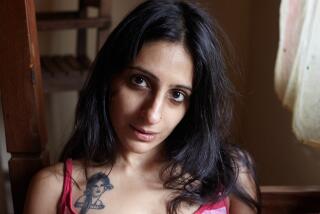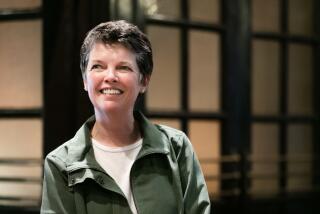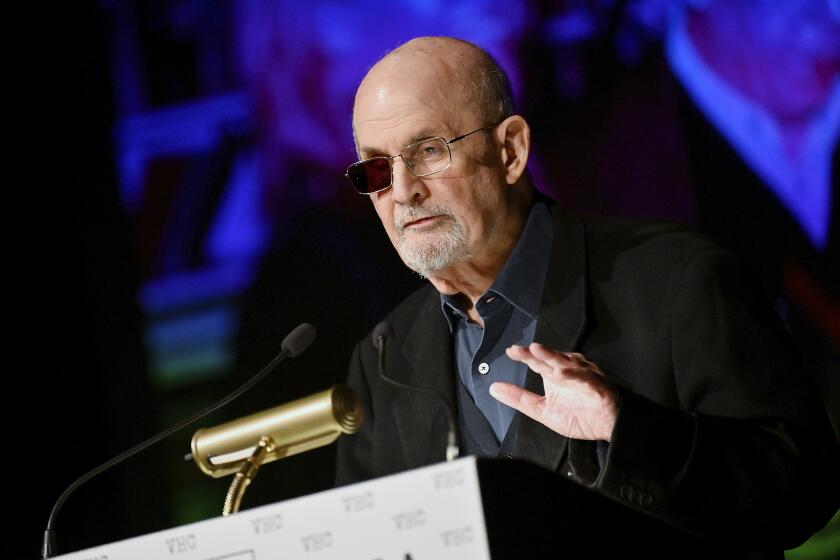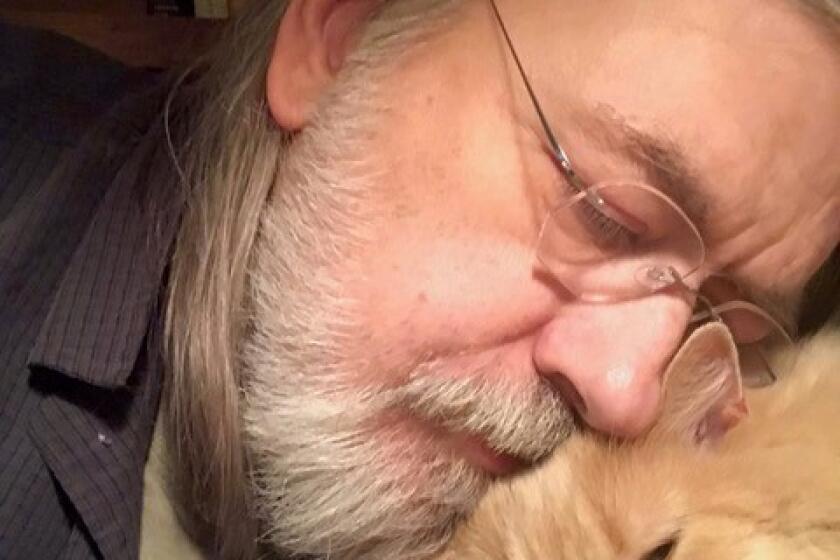Breathing literary life into ‘50s Cuba
When Americans think of ‘50s Cuba, they tend to picture Che Guevara with beard and cap, Fidel Castro ranting in tattered fatigues -- and maybe the romantic early days of the members of the Buena Vista Social Club.
But a new novel shows us, instead, United Fruit Co. executives in starched linen suits, daughters who play Chopin preludes on pianos groaning with humidity, a mysterious exotic dancer who comforts dictators, and company wives who wile away their days in a cocktail haze, dreaming of French perfume. The cane cutters and “the help” are viewed mostly obliquely, as if through the shimmer of tropical heat. Just before the revolution, then, we see the crisp world of Anglo privilege it overturned.
These scenes were created, or re-created, by Rachel Kushner, an L.A.-based art writer whose compelling debut novel, “Telex From Cuba,” is out this week with strong early reviews (as well as a coveted blurb from writer’s writer Paula Fox).
The book was built from extensive research, as well as family lore: Her mother spent four years, before her 15th birthday, in what was then called Cuba’s Oriente province, the daughter of a middle-class nickel-mine manager.
“She was slightly aware at the time, and certainly aware later, of a kind of disparity between the way they lived in the American colony and the way the Cubans lived,” Kushner, a youngish 39-year-old, said while eating moros y cristianos, or black beans and rice, at a Cuban restaurant near her home in Echo Park, which she shares with her professor husband and their 10-month-old son.
“But I think it was a very free place for a child, compared to living in the States. Especially in the ‘50s: Things were racially a little more mixed than they were here, and it was just a wonderful place to be a kid -- very tropical, very beautiful.”
Two of the novel’s key characters are children: This allows Kushner to frame a complicated racial and political situation through relatively innocent eyes, free of both ideology and adult politeness. But more practically, the children of the ‘50s are, in many cases, still alive to serve as sources, while the adults of the period have mostly passed away. (Several of Kushner’s subjects died as she researched the book.)
She was struck, during the interviews she conducted on visits to Cuba and Florida, by the intensity of her subjects’ memories as their stories called a lost world back into being. What she’s writing about, after all, is a place “essentially wiped off the map.” She has a hard time making simple sense of it all.
“A historical event represents the best and the worst of that moment,” said Kushner, a graduate of UC Berkeley and Columbia who, despite her dedication to Hegelian theory, comes off as casually bohemian. “There were people in Cuba who truly had substantial things to gain from revolution. There were people who had things to lose in the revolution. I think they’re all allowed to have their memories of what happened.”
The research trips
Kushner -- who was raised in San Francisco’s Haight district by poetry-loving scientist parents and moved to L.A. in 2003 -- made three long visits to Cuba over the six years it took her to write the book. Most of the novel takes place in Oriente (Spanish for “East”), a fertile province then owned almost entirely by American interests. (Roughly 330,000 acres of sugar cane fields were owned by United Fruit.)
“It became a treasure hunt in a way: There are no public libraries of any kind in Preston or Nicaro,” the towns where the novel was set. “But I would hear a rumor, like ‘so-and-so has every copy of the United Fruit Co. magazine,’ and I would show up with this little entourage and knock on their door.”
She came across a wide range of political views -- some sympathetic to the revolution, others who called Cuban workers “peons” -- as well as memories, from the child who sees his father burned and bleeding from the fires set in his fields to the butler who became a town mayor after the revolution. Her grandfather’s assistant became what she calls a national hero because of his technical ability at the nickel plant after the Americans left.
“I wanted to bring out the excitement of the revolution and also give some sense of why it overlooked some of its brighter possibilities,” she said. “The thrill of liberation from the cane cutters, the loss of that world for the Americans, the kids who loved it and had to leave. And also this very open moment . . . of what could happen before things became ideological.”
Her most important source was the son of a United Fruit manager -- ages 9 and 15 during the events of the novel -- who serves as the model for one of her narrators. Kushner calls him the novel’s muse.
“He talked about his life as if it was a childhood paradise for him -- and he wasn’t a sentimental man. But he paused at a point and said, ‘We went down there, and we took.’ And I stole that line for the book, because it just rang so true.”
There’s also a jaded Frenchman with a Nazi past and shady ambitions. “There was no notoriety and no shame,” the narrator says of his arrival, “and instead, a power shuffle that was an open call to opportunists.”
Other characters, loosely based on her mother’s family, come from Tennessee and head to Oriente because they are not comfortable with their status back home. “It kind of speaks to the time,” Kushner said, “when people tried to move to these tropical locations to ratchet themselves up a little bit to a higher class.”
Kushner, whose favorite novelists include Proust and Roberto Bolano, worked hard on the research: As an American writing about a time and place she’d never experienced, she was not in a position to fake it. And while the wealth of interview and research material made her novel possible, it wasn’t exactly easy.
“I think there’s an inevitable process of failure you move yourself through,” she said. “The material itself is not the armature for the story, even though it seems like it would be. You have to work backward, as a kind of framing, from something that we all know happened -- the revolution. But I had to throw out everything I wrote and start over.
“It’s a cliche, and in a way it’s a conservative idea about fiction, but I did learn the hard way that plot does need to dictate the story. Even if it happened in real life -- and oftentimes, especially if it happened in real life -- it might not work in fiction. So I probably used 10% of my research: You learn after a point that you can’t have a precious relationship with historical facts.”
A friend’s surprise
Laura Owens, a friend of the writer and an L.A. painter, remembers Kushner’s trips to Cuba and her sweating over the structure. “At first I really couldn’t imagine that she had written it, because it’s not something I’m expecting from someone in our crowd, it’s so historical.
“One of my favorite books is ‘Things Fall Apart,’ and this would be a fun book to read after you’d read that; it’s from the opposite point of view. Fifty years after Chinua Achebe’s writing, here’s Rachel, getting at what’s happening as the colonial moment is falling apart. You know what’s gonna happen, but you get at it in such an indirect way, since she’s writing through these kids, with just the basic things they go through, like clothes and worries about dances and things like that.”
Kushner is aware, of course, that the revolution didn’t go the way everyone had hoped. “Here we are in a Cuban restaurant in Los Angeles,” she said, “but in Nicaro and Preston there are no restaurants; there would be nothing for people to prepare to serve at a restaurant. There are never enough beans.” She knows the island’s history of human rights abuses.
“That said, I’m an outsider, so I’m a little reticent of my take on the place.”
Kushner got a firsthand reminder of her outsider status on one of her visits, while staying with an old friend of her mother’s. The sight of their rental car provoked a visit from a government clerk and exhortations of “I’ll hang! I’ll hang!” by their host.
When she and her mother went to the provincial capital to sort out the matter, which hinged on a mislabeled visa, “We waited five hours in the boiling sun, and then we were called into this office. It was like being in East Germany a little bit. There was a huge pile of dirt on the floor they were excavating. And this surly feeling of bureaucratic unease. Part of me was completely enraged, but I’m used to having my freedom,” Kushner said.
“But you’re in a place where you are not setting the rules.”
--
--
Rachel Kushner readings
Where: Hammer Museum, 10899 Wilshire Blvd., L.A.
When: Wednesday, 7 p.m.
Contact: (310) 443-7000
Also
Where: Skylight Books, 1818 N. Vermont Ave., L.A.
When: Friday, 7:30 p.m.
Contact: (323) 660-0232
More to Read
Sign up for our Book Club newsletter
Get the latest news, events and more from the Los Angeles Times Book Club, and help us get L.A. reading and talking.
You may occasionally receive promotional content from the Los Angeles Times.






